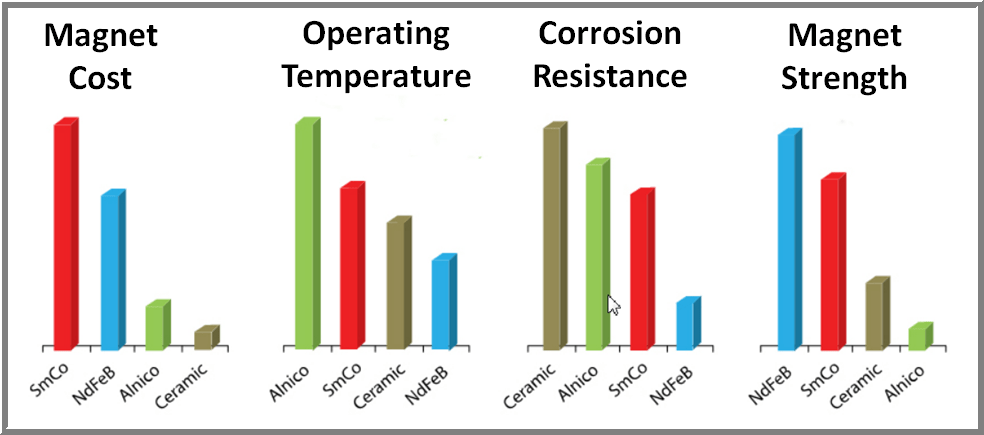A customer’s recent four magnet sample request (similar shape/size in Neodymium, Samarium Cobalt, Alnico, and Ceramic Ferrite) illustrates some of the challenges associated with selecting the proper magnet material. Instead of simply fulfilling this request, we took the time to discuss project specifics and learned that our customer was interested in reducing the cost and maintaining as much performance as possible. We also discovered this project required production run quantities of magnets capable of withstanding prolonged exposure to heat and demagnetizing fields. Each magnetic alloy offers unique characteristics that are ideal to specific applications. Keeping our customer’s objective in mind we narrowed down the material options to neodymium or ceramic. Alnico was ruled out due to its relatively low energy density and Samarium Cobalt because of its high cost.
In a previous post about N52 Neodymium magnets , we noted instances where customers pay for a high grade of Neodymium that they don’t actually receive or need for their application. In this case, the use of better quality of Neodymium would significantly improve performance, but the high volume requirements suggested that a Ceramic Magnet was the best option. With all of this said, how do you know which magnet material is best for YOUR application?
Samarium Cobalt vs. Neodymium vs. Ceramic vs. Alnico
Comparison of key characteristics of magnet materials.
Ceramic, Neodymium-Iron-Boron, Alnico, and Samarium Cobalt are some common examples of material we fabricate and supply. Many of these are typically produced using a sintering or casting process. Although ‘as cast’ shapes typically require little surface treatment, most sintered products go through additional grinding or machining operations prior to use. Some of the more important considerations during the magnet material selection process include operating temperature, environment, required strength, and air-gap.
Each magnetic alloy offers unique characteristics that lend itself ideal to the application. Ceramic is popular due to its moderate energy density and low cost, but Neodymium Iron Boron is often the material of choice thanks to its high strength and reasonable cost. Alnico provides the highest operating temperature of all magnetic materials; however there are limitations to its performance due to its inherent characteristics. The last and least widely used magnetic material is Samarium Cobalt. Samarium Cobalt provides very good response to elevated temperatures and the second highest available energy density, but the biggest trade-off with Samarium Cobalt is its comparatively high cost.
Due to the hardness and brittleness of magnetic materials, it is often desirable to produce magnets in simple geometries such as discs, blocks, or rings. When features such as counter-sinks, through holes, tapers, or shoulders are required, we can offer a custom fabricated option, including development of a magnetic assembly. A magnetic assembly is in essence the integration of a magnet, most commonly into a metal housing. Both ferrous and non-ferrous metals can affect the performance of the magnetic assembly but regardless of the design, the magnetic assembly is often more effective in achieving the magnetic requirements than simply using a magnet by itself. Dura combines our assembly capability with abrasive grinding, EDM, and other non-conventional machining methods to produce magnet geometries ranging from simple discs, blocks, rings, and arcs to complex and intricate shapes in a wide range of magnetic alloys.
Dura’s applications and engineering team can save you valuable time when selecting the proper magnet material, helping to implement a solution tailored to your specific requirements. We’ll provide a comprehensive overview of your request and educate you along the way so you can make the best possible decision. Whether your magnet application requires high strength, resistance to extreme operating conditions, or a high-volume, cost-effective solution, Dura Magnetics can help. If you need assistance selecting the proper magnet material for your application, feel free to contact a Dura Magnetics team member via email, or call 1-800-492-7939 for more information.


